This bird whisperer is keeping the 4,000-year-old tradition of falconry alive in L.A.
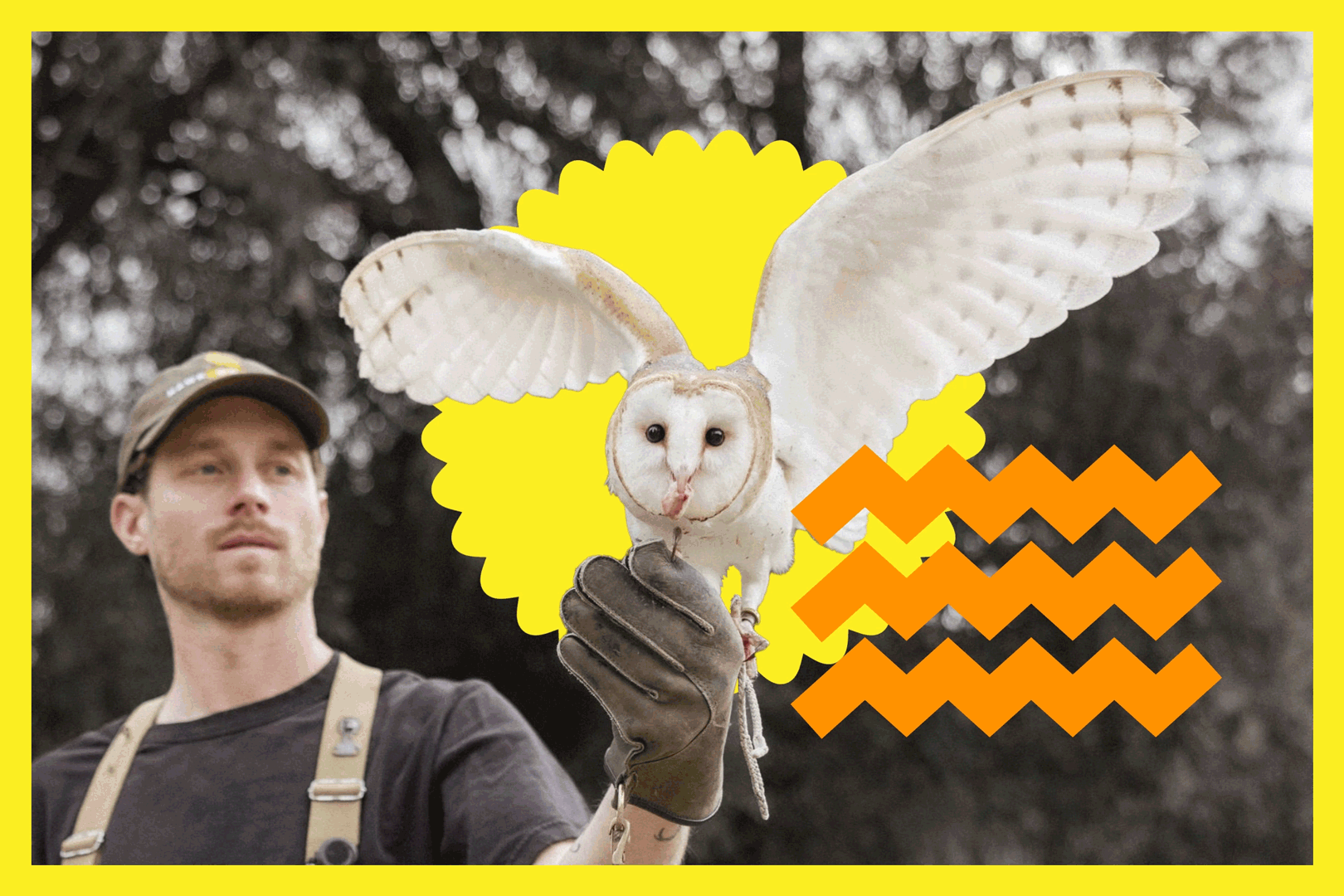
- Share via
The concept of falconry may bring to mind a Mongolian warrior watching a hawk soar across the steppe. Or maybe a medieval knight surveying a forest. I’ll bet it does not conjure the image of a slim 39-year-old man in a baseball cap and T-shirt with intricate tattoos of animals and leaves covering his arms. But on a recent Sunday morning, that’s exactly who I watched direct a small flock of birds of prey around Ernest E. Debs Regional Park.
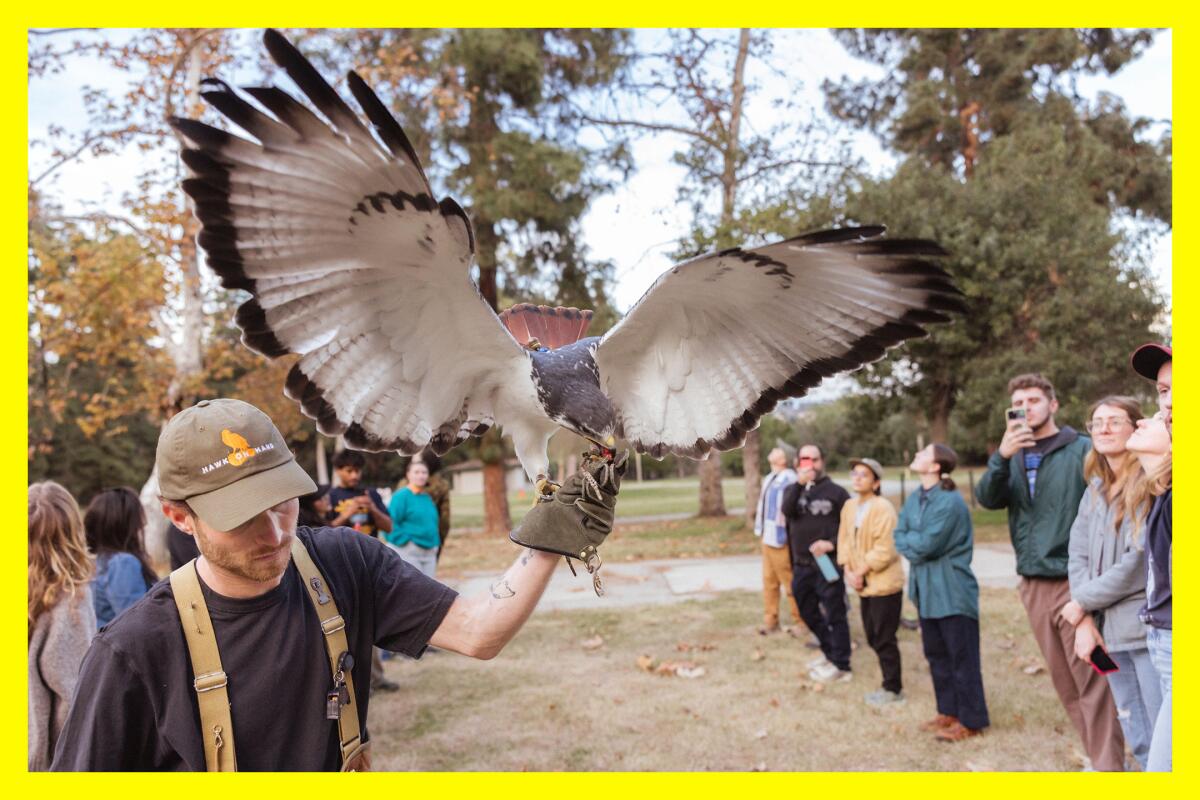
Adam Baz (known to his 37,500 Instagram followers as Hawk on Hand) is a modern-day falconer, though his craft is thousands of years old. Falconry is believed to have begun in Central Asia and the Iranian Plateau in the Bronze Age, when people learned to harness raptors’ natural instincts to hunt small game. Fast-forward a few millennia, and Baz’s journey to falconry began with conservation. He started out as an avian biologist, studying birds across the western U.S. It was important work, but the job left him feeling disappointed. Wild birds wanted nothing to do with him.
You are reading The Wild newsletter
Sign up to get expert tips on the best of Southern California's beaches, trails, parks, deserts, forests and mountains in your inbox every Thursday
You may occasionally receive promotional content from the Los Angeles Times.
For the record:
4:44 p.m. Feb. 26, 2024The first three photos in this newsletter were taken by Mike Pham, not Adam Baz.
1:00 p.m. Feb. 22, 2024The CicLAvia event on Melrose Avenue will take place on Sunday, Feb. 25, not Saturday.
“It was comically frustrating,” Baz said. “I had devoted a decade of my life to studying these animals that would prefer to be as far away from me as possible.”
He yearned for “a more harmonious, mutually beneficial relationship with a bird,” he said, which led him to falconry. Although he had concerns about the practice at first, his mandatory two-year apprenticeship — which involves trapping, training, and then releasing a wild bird — was eye-opening. The practice gave him what he’d been searching for: A closer relationship with birds of prey.
“I realized that there’s a way to be a falconer that benefits both the falconer and the bird,” he said. “Then I just was hooked, and haven’t stopped doing it since.”
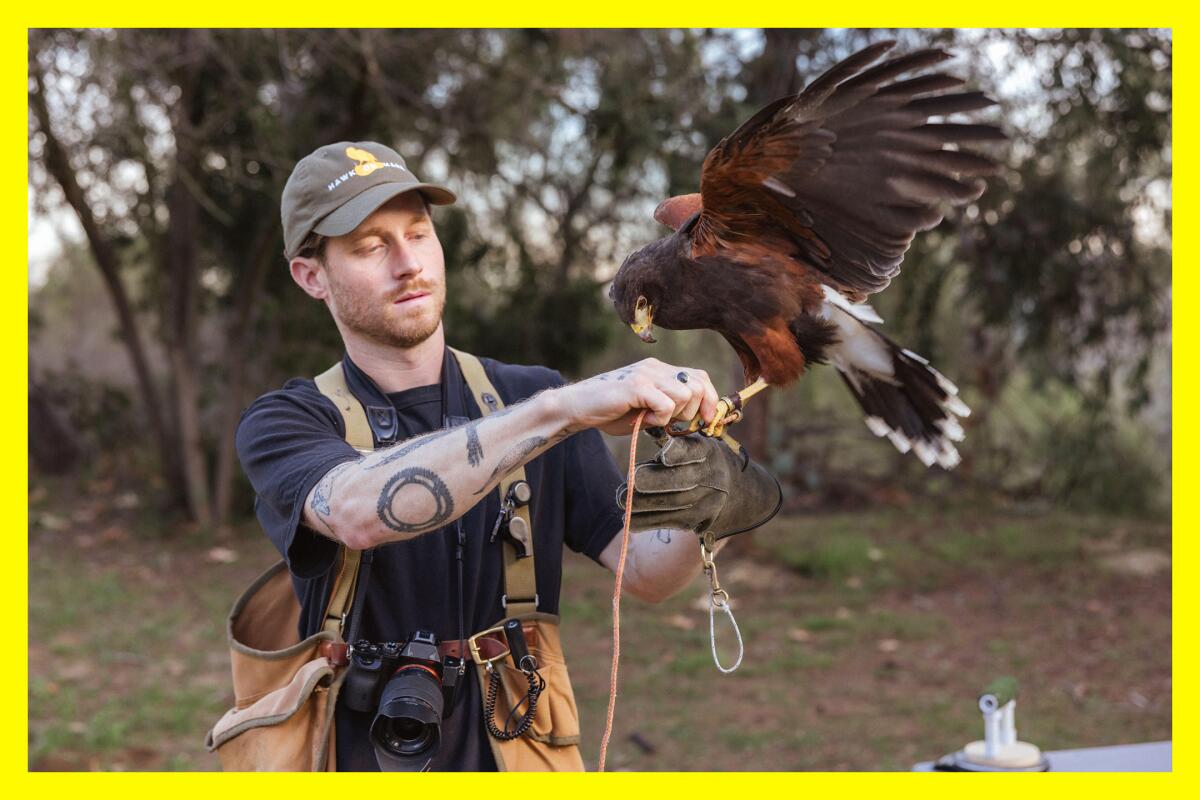
That morning at Debs park, Baz introduced me, along with about 18 other people, to the ins and outs of falconry as part of a monthly class he offers through Usal Project. Over the course of the class, we met three birds, including Archie, a barn owl with wispy mottled white-and-brown feathers, and Kanoni, an augur buzzard native to eastern Africa. Seeing the birds up close was incredible, and Kanoni, with her massive wingspan and prominent yellow beak, was a particularly impressive figure; I knew she could easily pick out my eyeball and gulp it down like a cocktail olive.
My favorite interaction was with Jasper, a Harris’s hawk. When my turn came around, I pulled on a heavy leather glove and clasped a chunk of frozen mouse meat between my thumb and forefinger. Baz used a laser pointer to get Jasper to land on a nearby tree branch. Then I raised my arm and Jasper took off, swooping low across the grass, wings spread wide, before arcing upward and perching on my gloved hand to receive his reward. The whole operation felt smoothly coordinated between Baz and Jasper.
That coordination is critical, because these birds have a day job. In addition to falconry classes and hunting trips, Baz uses his raptors to run an aerial pest control business: They scare away pigeons, seagulls and crows from parking lots and skyscrapers, including several buildings in downtown Los Angeles. Using his laser pointer, Baz will direct his animals to fly into specific areas and scare pigeons to keep them from congregating. It’s tricky work on a good day, and the hazards of urban life, including speeding cars and curious pets, make it even more challenging.
“I’m paying attention to the traffic, to the people around, the dogs, other hawks and falcons, and then releasing and calling my birds back to me at very precise moments in order to keep them safe,” Baz said.
It works because Baz and his feathered companions have developed a rhythm over the years that keeps them safe and motivated even in stressful environments. I was lucky enough to get a glimpse of it in class.
“Once you get the bird to the point where they’re comfortable with you and they trust that you’re keeping them safe, they seem to be just as content flying in the middle of downtown L.A. as in the countryside,” Baz said.
Want to get a closer look at falconry? Sign up for one of Baz’s classes: There’s an upcoming event in March with Usal, or keep an eye on the Hawk on Hand website, as a new batch of private class slots (accommodating groups of 1-4 people) will open up in the coming weeks.
When you go, say hi to Jasper for me!

3 things to do
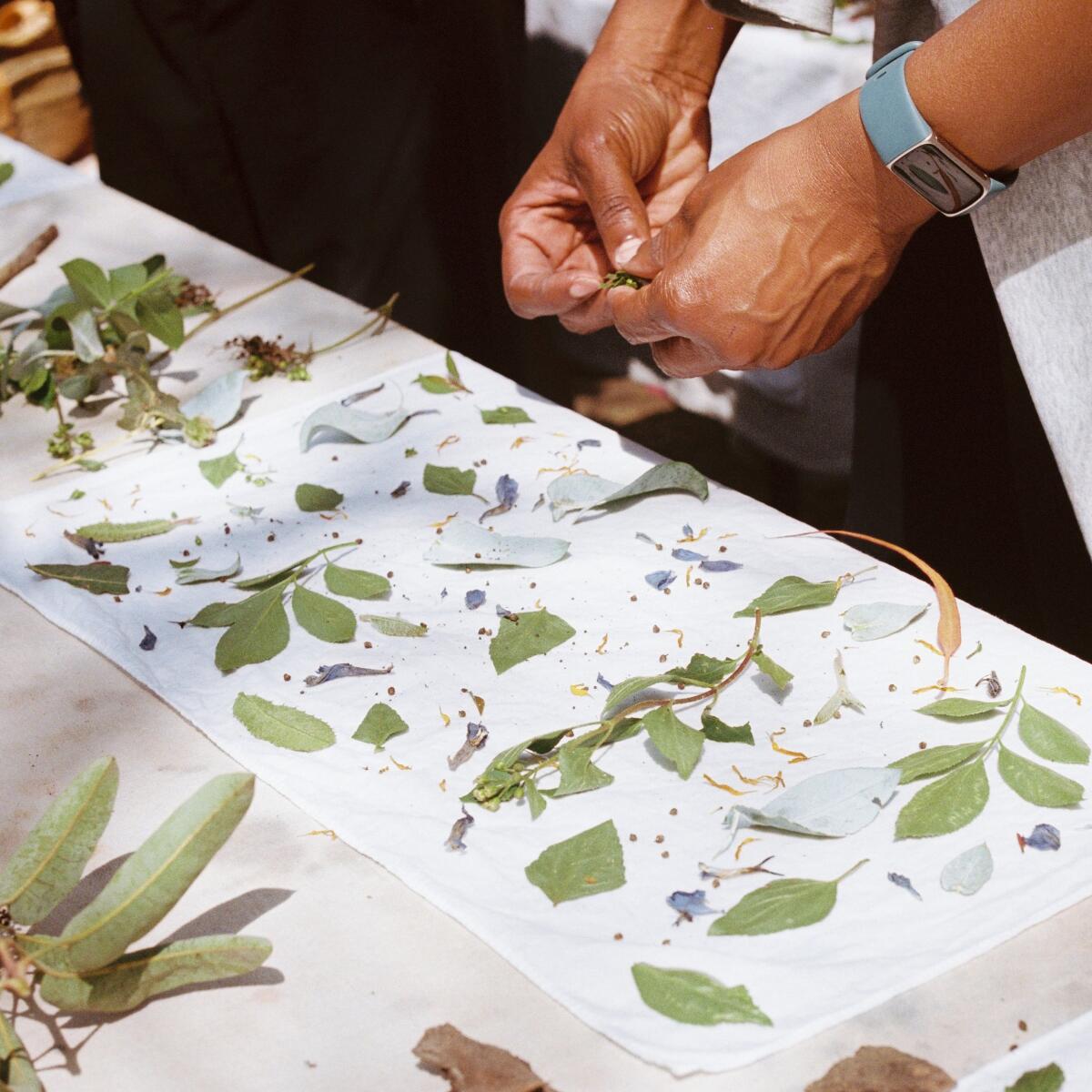
1. Study nature’s palette in Altadena.
Discover the local flora best suited for natural dye-making on a one-to-two-mile foraging hike led by artist, educator and naturalist Erin Berkowitz. She’ll show you how to identify the most colorful plants in the Arroyo, and how to forage, grow and harness their creative potential to make “unique eco-prints.” You’ll leave with local plant dye recipes, a wearable plant-dyed item, and a greater appreciation for the inherent beauty of Californian ecology. The event is a collaboration between Berkowitz’s Berbo studio and the local native plant store, Plant Material. It takes place Sunday from 10 a.m. to 2 p.m. Tickets are $85 each and can be purchased on the berbostudio.com.
2. Glide down a car-free Melrose Avenue.
CicLAvia will be shutting down a four-mile stretch of Melrose Avenue, between Fairfax Avenue and Vermont Avenue on Sunday, from 9 a.m. to 3 p.m. so bikers, roller-skaters and skateboarders of all ages can gather and glide on a human-powered vehicle of their choice. Get more information about the non-profit’s 50th annual event at ciclavia.org.
3. Run to honor Mother Earth in Long Beach
Run a 5K with the Friends of Puvungna, a group dedicated to protecting the Indigenous land where Cal State Long Beach now stands. The “prayer run & walk” will include an opening blessing, prayers “for healing far and wide across Mother Earth” and traditional songs and dancing. It kicks off Sunday morning at 8:30 a.m. and registration is donation-based, on a sliding scale of $10-$25. Sign up on this Google form.

The must-read
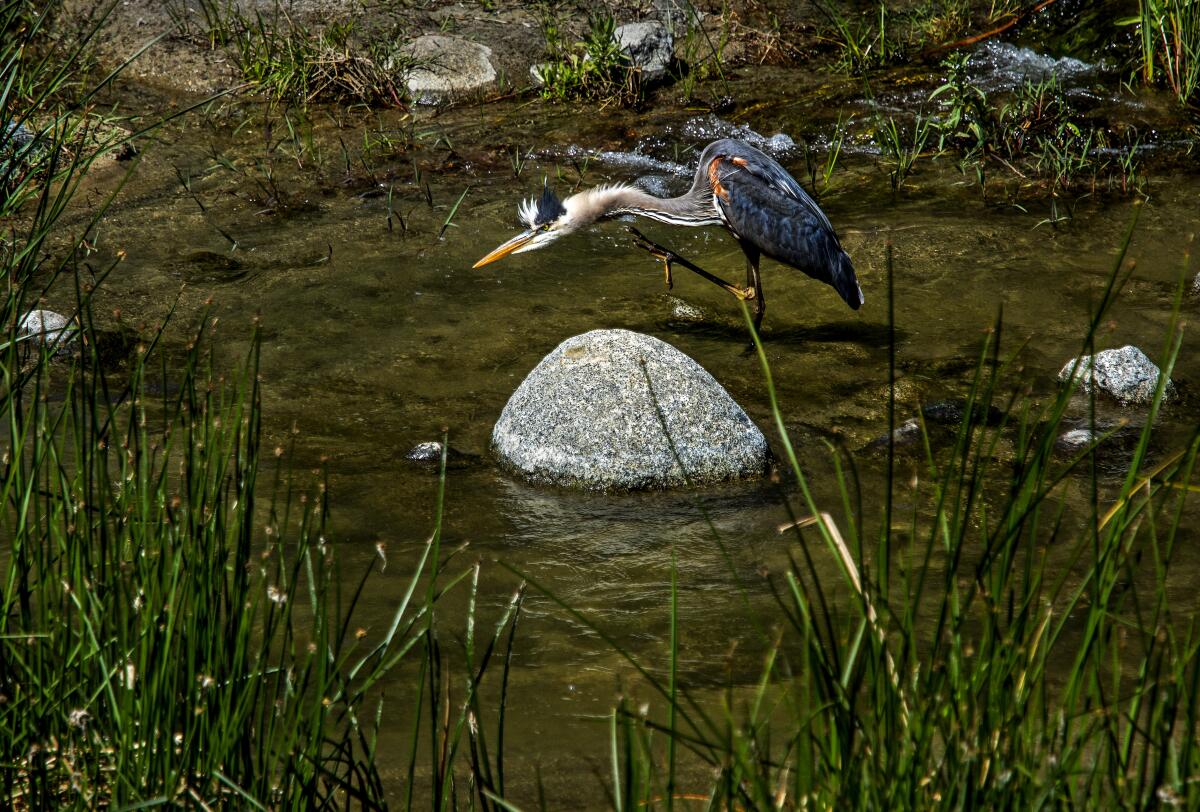
I really enjoyed this New York Times article exploring how defunct golf courses are increasingly being revamped into nature preserves, with cart paths getting a new life as hiking trails and fairways turning into meadows and grassland. To illustrate the trend, the piece focuses on two courses-turned-preserves in California: San Geronimo Commons in Marin County and the new Prescott Preserve in Palm Springs. Next time you’re in either area, make sure to stop by and see how the rewilding process is unfolding — no tee times required.
Happy adventuring,

P.S.
Attention, map nerds: The Historic LA Instagram account is giving away a free print (although you’ll have to cover shipping). It’s an 8 by 10 color photo showing a moody nighttime view of Vine Street in Hollywood in 1966 — a great addition to any L.A. home or office.
For more insider tips on Southern California’s beaches, trails and parks, check out past editions of The Wild. And to view this newsletter in your browser, click here.
Sign up for The Wild
We’ll help you find the best places to hike, bike and run, as well as the perfect silent spots for meditation and yoga.
You may occasionally receive promotional content from the Los Angeles Times.




